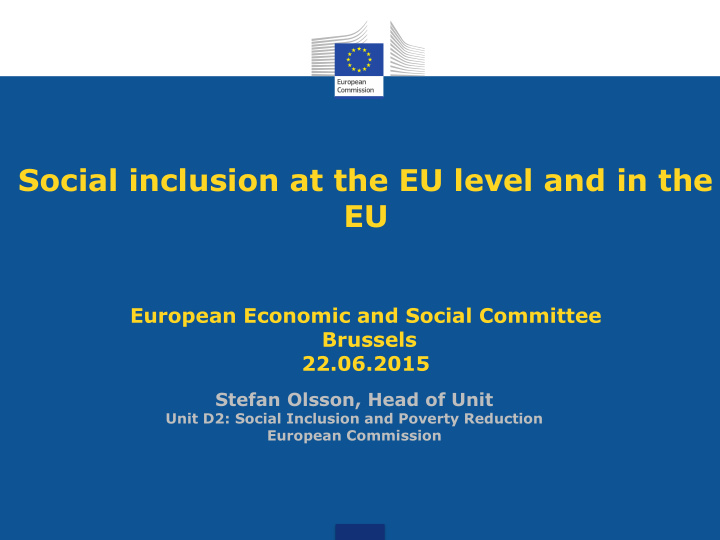



Social inclusion at the EU level and in the EU European Economic and Social Committee Brussels 22.06.2015 Stefan Olsson, Head of Unit Unit D2: Social Inclusion and Poverty Reduction European Commission
Role of social policies
EU inclusive growth strategy: EU 2020 targets Proposed by the Commission and agreed by the European Council in March 2010: all Member States were invited to set national targets on this basis.
Development of the EU 2020 headline target on poverty and social exclusion 4
EU-level actions to help deliver on the target 1. Policy guidance: the Recommendation on active inclusion, Social Investment Package and its Recommendation on Investing in Children, White Paper on Pensions, Employment Package, Youth Employment Package 2. European Semester: monitoring Member State's reforms and proposing country-specific recommendations. 3. Analytical support and in-depth thematic reviews through the Social Protection Committee 4. Mobilisation of EU Funds: ESF, EaSI, Youth Employment initiative, FEAD 5. Dialogue : European Platform against Poverty, funding of NGO networks
1. Policy guidance • Example: assessing income support for the working age population • Challenges: • No Adequacy • Low Coverage • Non-take up • Work disincentives • Relationship between minimum income and minimum wage • Designing proper incentives: benefit reduction rates, harmonizing tax and benefit system 6
Adequate income support Net income of Non-coverage Net people on Coverage of rate of jobless replacement social Unemploymen unemploymen poor - child rate of assistance Inactivity trap t trap t benefits benefits unemploymen relative to excluded t benefits median income DK 92.6 8.2 79.9 71.7 81.6 78.7 FI 89.8 3.3 70.6 54.3 69.1 57.6 NL 61.9 6.1 77.6 63.3 81.2 66.3 SE 35.1 5.0 67.9 49.0 67.4 53.0 FR 70.9 8.6 73.0 39.7 74.2 48.0 BE 86.1 15.2 69.7 46.3 77.6 60.6 AT 77.4 25.3 66.5 48.3 72.9 61.0 DE 84.2 18.8 66.4 53.3 76.9 61.6 SI 41.0 13.6 66.1 42.3 81.9 60.8 IE 69.3 21.4 69.8 72.7 60.0 60.8 UK 39.7 22.6 48.3 69.0 43.3 57.0 ES 61.7 35.7 72.2 31.0 76.8 37.8 PT 40.8 42.3 80.9 37.0 81.1 39.8 CY CZ 55.9 31.5 50.9 45.7 74.4 53.8 IT 56.2 45.7 52.8 74.6 24.6 MT 50.7 19.7 54.9 52.3 51.4 46.2 EE 50.7 30.4 49.4 32.3 62.0 41.9 HU 64.5 16.5 51.8 33.0 74.1 42.2 LV 46.0 29.8 58.4 44.0 86.1 55.6 PL 26.5 39.3 51.5 35.0 63.1 49.2 BG 21.5 44.7 62.7 20.7 80.9 35.6 EL 43.5 68.2 44.3 3.7 53.4 24.5 LT 21.3 21.4 48.7 53.3 63.3 55.5 RO 38.6 39.1 48.9 23.3 53.9 36.8 SK 37.5 29.2 44.6 28.7 43.1 29.8 7 LU 54.1 23.6 72.2 52.0 86.5 58.4
2. European Semester: Policy reforms in 2015 country-specific recommendations (Commission proposals) • Improving adequacy and sustainability of pensions • Efficient and effective social transfers (children, families, older people or improving incentives for the working age) • Activating policies for those furthest from the labour market • Improving simplicity, adequacy or coverage of unemployment benefits/social assistance and linking to activation • Improving access to healthcare • Inclusive education and educational support or early school leaving • Improving long-term care services and cost-effectiveness 8
Examples for CSRs in the field of social inclusion in 2015 Semester (proposals) • Eight Member States ( BG, ES, HU, IE, LT, LV, PT, and RO ) have received CSRs in the area of income support and link to activation highlighting the importance of comprehensive measures based on income support, activation, and access to services • Seven Member States ( AT, CZ, EE, IE, RO, SK, and UK ) have also received CSRs on access, affordability, and/ or quality early childhood education and care (ECEC) in order to support female labour market participation • This year, improving access to education for the Roma population have also received special attention: five Member States ( BG, CZ, HU, RO , and SK ) received CSRs on increasing participation of Roma in the mainstream education including ECEC 9
3. Commission activities: examples Knowledge sharing: European Platform for investing in children Analytical support: Assessing financing, Studies and pilot projects effectiveness, and efficiency of Call for proposals to support social protection systems integrated social service delivery Reference budgets to ensure adequate income support
Monitoring of social policy reforms, assessing social protection expenditure • Need for more effective and efficient social policies to ensure adequacy and sustainability of social protection systems • A methodology for better informed policy-making: • Guide and monitor social reforms in cooperation with the Social Protection Committee • Identify complementarities and trade-offs across policy areas • Take inter-linkages with employment and fiscal policies into account • SPC report on financing, effectiveness and efficiency of social protection systems adopted in early November 11
4. EU Funds - 2014-2020 European Social Fund ~ € 80 billion • Main budgetary instrument for supporting structural reform and investment in employment and social policy • Minimum 20% to social inclusion; € 3billion to Youth Initiative Fund for European Aid to the Most Deprived ~ € 3.8billion • Addressing extreme forms of material deprivation Programme for Employment and Social Innovation ~ € 9.19 billion • Supporting social policy innovation - scaling up • Micro-financing to provide start-ups for entrepreneurs • Supporting EU-level NGO networks 12
Way forward • 2015: • An Investment Plan for Europe • Relaunch of the Social Dialogue • Long-term Unemployment Initiative • Mobility Package • Europe 2020 Midterm review • Beyond…: • Upward social convergence: • Reinforce of policy coordination in the European Semester through benchmarks • Reinforcing the legal acquis to protect workers from the risks of today and tomorrow 13
Thank you for your attention! 14
Recommend
More recommend